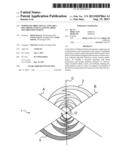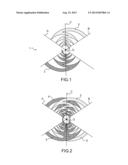Patent application title: Wideband, Directional, Linearly Polarized Antenna Having High Polarization Purity
Inventors:
Michel Jousset (Ploumoguer, FR)
Gaetan Guevel (Quimper, FR)
Gaelle Samson (Ploumoguer, FR)
Assignees:
THALES
IPC8 Class: AH01Q1110FI
USPC Class:
3437925
Class name: Communications: radio wave antennas antennas logarithmically periodic
Publication date: 2013-08-15
Patent application number: 20130207864
Abstract:
In the field of wideband directional antennas employing linear
polarization, and in particular in the context of amplitude goniometry
systems, polarization purity defects lead to deformation of the radiation
diagrams that increases with the elevation, inducing degraded detection
system location performance. An antenna is provided operating with linear
polarization and having radiating elements of "sinuous" shape inscribed
within a circle, and includes radiating elements printed on the two faces
of a support, the elements of the first face being deduced from those of
the other face by a rotation.Claims:
1. A wideband, directional, linearly polarized antenna having a plane
support and high polarization purity, having at least one pair of
radiating elements printed on one face of a printed circuit, the two
elements being symmetrical to each other with respect to a center of the
antenna and delimited in their angular extent by two virtual straight
lines passing through the center of the antenna, comprising: radiating
elements printed on the other face of the support, these elements being
identical to those of the first face, and being deduced therefrom by a
rotation of 180.degree. about an axis passing through the center of the
antenna and which is the bisector of an angle at the center of said pair
of elements, said angle at the center being that formed by said two
virtual straight lines, said rotation being followed by a translation
over a distance equal to the thickness of the printed circuit.
2. The antenna claimed in claim 1, wherein each face of the printed circuit includes two arms of sinuous shape.
3. The antenna claimed in claim 2, wherein each face of the printed circuit includes two arms of log-periodic shape.
4. The antenna claimed in claim 1, being a dual linear polarization antenna.
5. The antenna claimed in claim 1, wherein each face of the printed circuit includes two arms of log-periodic shape.
Description:
[0001] The present invention relates to a wideband, directional, linearly
polarized antenna having high polarization purity.
[0002] In the field of wideband directional antennas employing linear polarization, and in particular in the context of amplitude goniometry systems, there is generally observed, with antennas of this type, degraded accuracy of the measurement of the D.O.A ("direction of arrival") of targets. In this case, polarization purity defects lead to deformation of the radiation diagrams (this phenomenon is known as "clouding") that increases with the elevation, inducing degraded detection system location performance.
[0003] This problem is currently solved with the aid of empirical solutions that cannot be generalized, for example the addition of arrays of metal wires in front of the antenna.
[0004] The subject matter of the present invention is a wideband (the frequency band possibly exceeding a decade), directional antenna having high polarization purity, of the printed circuit type, which antenna can be integrated into a dual polarization antenna and, when it is used in a location system, enable improvement of the location performance thereof, particularly at non-zero elevations.
[0005] If this antenna is of the linearly polarized type, its theoretical copolarization is defined relative to the geometry of the radiating circuit. In practice, the real copolarization differs from the theoretical copolarization. The polarization purity is defined as being the difference between the theoretical polarization and the real copolarization. It may be measured using the "copolarization level/cross-polarization level" ratio in the geometrical definition plane of the antenna. If the antenna is perfect, this ratio is infinite. In practice, what is looked for is a ratio generally between 15 dB (for a log-periodic type antenna) and 20 dB (for a "sinuous" antenna).
[0006] The antenna of the invention, of the plane support type, is a wideband, directional, linearly polarized antenna having high polarization purity, having at least one pair of radiating elements printed on one face of a printed circuit, the two elements being symmetrical to each other with respect to the center of the antenna and delimited in their angular extent by two virtual straight lines passing through the center of the antenna, and is characterized in that it includes radiating elements printed on the other face of the support, these elements being identical to those of the first face, and being deduced therefrom by a rotation of 180° about an axis passing through the center of the antenna, and which is the bisector of the angle at the center of said pair of elements, this angle at the center being that formed by said two virtual straight lines, this rotation being followed by a translation over a distance equal to the thickness of the printed circuit.
[0007] The present invention will be better understood on reading the detailed description of one embodiment considered by way of nonlimiting example and shown in the appended drawing, in which:
[0008] FIG. 1 is a plan view of a prior art antenna, and
[0009] FIG. 2 is a plan view of an antenna conforming to the present invention.
[0010] The present invention is described hereinafter with reference to an antenna operating with linear polarization and having radiating elements of "sinuous" shape inscribed within a circle, but it is to be clearly understood that it is not limited to any such type of antenna, and that it applies to any antenna with plane radiating elements, radiating with linear polarization, having a wire geometry, where the aim is to improve the polarization purity, the copolarization of which antenna is assumed to be linear, wideband or otherwise, which may, where necessary, be the basic element for the design of a dual polarization antenna.
[0011] The type of antenna from which the invention stems is generally that produced with the aid of a single-sided printed circuit fabrication technology. One example of a prior art antenna 1 of this type is shown in FIG. 1. It essentially comprises two sinuous radiating elements or branches 2, 3 symmetrical to each other with respect to the geometric center O of the system. It is to be clearly understood that this antenna could include two other branches. The layout of the radiating elements of a so-called "sinuous" antenna being well known, for example from U.S. Pat. No. 4,658,262, it will not be described in more detail here. It will be specified here only that the two arms 2, 3 are symmetrical to each other with respect to the center O. These two arms are delimited in their angular extent α by two virtual straight lines A, B passing through the center O of the antenna.
[0012] The antenna 4 of the invention, as represented in FIG. 2, is of the double-sided printed circuit type. The representation in FIG. 2 is as if the printed circuit on which the radiating elements are formed were transparent. The first face, which is assumed to be the anterior face, includes the same branches 2, 3 as in FIG. 1. The posterior face of the printed circuit includes the branches 4,5 the shapes and dimensions of which are identical to those of the branches 2, 3.
[0013] In the FIG. 2 view, the location of the branches 4, 5 is deduced from that of the branches 2, 3 by rotation to 180° about an axis C passing through the center O and which is the bisector of the angle α at the center of the branches 2, 3. In reality, it would be necessary to add to this rotation a translation over a distance equal to the thickness of the printed circuit (from the anterior face to the posterior face of this printed circuit). In other words, the layout of the branches 4, 5 is obtained by rotation of the branches 2, 3 about the center O through an angle having a value equal to (180°+α), and then by the same translation. In the case of an antenna with four branches (two pairs of branches), only one of the pairs is considered for this rotation.
[0014] The invention enables improvement of the polarization purity of the antenna by more than 10 dB compared to the geometry on a single-sided printed substrate. More generally, it enables improvement of the polarization purity of all plane wire antenna geometries (log-periodic and other type antennas). Applied to dual polarization antennas, it improves the coupling between the two radiating elements.
User Contributions:
Comment about this patent or add new information about this topic:
| People who visited this patent also read: | |
| Patent application number | Title |
|---|---|
| 20160354472 | USE OF HUMAN SERUM ALBUMIN TO DECREASE ANTIGENICITY OF THERAPEUTIC PROTEINS |
| 20160354471 | Pine Bark Extract and Black Pepper Essential Oil with Anti-Inflammatory and Anti-Arthritic Action and Method of Preparing |
| 20160354470 | SUSTAINED-RELEASE DRUG CARRIER COMPOSITION |
| 20160354469 | Composition, its preparation and method of use in treating skin disorders |
| 20160354468 | (BACTERIO)CHLOROPHYLL PHOTOSENSITIZERS FOR TREATMENT OF EYE DISEASES AND DISORDERS |


